
Here's my edition of Top 10 links from around the Internet today.
We have a Monday-Wednesday-Friday schedule for Top 10. Bernard will be back with his version this Wednesday. We will have another guest posting on Friday.
As always, we welcome your additions in the comments below or via email to david.chaston@interest.co.nz.
See all previous Top 10s here.

1. The next 10 years ...
The worldwide demand for food and the prices people are prepared to pay is what will define New Zealand for decades to come.
So it is wise to keep an eye on the global forecasts.
The OECD/FAO Report on that very subject was released last week, and policy makers here will be pleased with the strategy we have, I suspect.
Both dairy and red meat markets look promising in these reviews.
In fact, the recent fall in grain prices may not last, although with rising demand from changing diets, dairy and red meat supply will fall behind demand. Real prices should stay high, and at a level New Zealand can live with.
You can use the very handy interactive tool to make your own assessments of changing supply and demand trends.
New Zealand is well placed.
Demand for agricultural products is expected to remain firm although expanding at slower rates compared with the past decade. Cereals are still at the core of human diets, but growing incomes, urbanization and changes in eating habits contribute to the transition of diets that are higher in protein, fats and sugar.
In the next decade, livestock and biofuel production are projected to grow at higher rates than crop production. This changing structure of global agricultural production prompts a relative shift toward coarse grains and oilseeds to meet demands for food, feed and biofuel, away from staple food crops like wheat and rice. The bulk of the additional production will originate in regions where determining factors, such as land and water availability, and policy regulations, are the least constraining.
Crop prices are expected to drop for one or two more years, before stabilizing at levels that remain above the pre-2008 period, but significantly below recent peaks. Meat, dairy and fish prices are expected to rise. In real terms, however, prices for both crops and animal products are projected to decline over the medium term. The expected stock-to-use ratios for cereals improve significantly, which should ease concerns about their price volatility.
World fishery production will be driven primarily by gains in aquaculture in developing countries. Sustained high costs in a context of firm demand will keep fish prices well above their historical averages, holding back consumption growth in the coming decade.
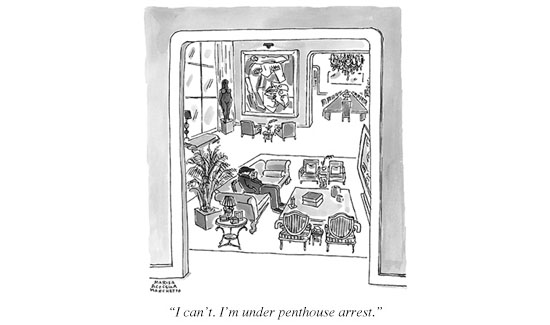
2. Out of its depth?
The Economist has pointed out that China now has debt levels equal to twice its GDP. That's high, especially for a developing economy, but nowhere near as high as Greece (260%) or Ireland (400%).
(New Zealand is at 180% with NZ$340 bln being the sum of household debt and borrowing by business and agriculture, plus the gross NZ$75 bln owed by the Government. Nominal GDP is running at NZ$227 bln.)
But does China face a debt headache? Most certainly. More worrying than the total debt level is the rapid rise. China’s credit-to-GDP ratio has risen by 58% since the start of 2009, when banks pumped out a torrent of loans to fund the government’s gargantuan stimulus programme. In recent years the government has tried several times to rein in debt, only to back down when it became clear that deleveraging would be painful.
But the reopening of the lending taps means debt is an even bigger burden for the economy. With credit at 200% of GDP and average financing costs of roughly 7%, Chinese borrowers now need to generate cash-flow growth of 14% to cover their interest payments without eroding their profitability or being forced to borrow yet more. That is a tall order in an economy in which nominal growth is now running at 9%.
The upshot is that China’s credit-to-GDP level looks set to continue its steady drift upwards. Debt is a habit that, once formed, is hard to break.

3. Bitcoin, meet Lawsky’s BitLicense
Bitcoin and its mimics might be the favoured currency of libertarians and other conspiracy-types, but it not long now before it will be regulated. New Zealand is getting ready. First out of the blocks is New York, with famed prosecutor-of-bankers Benjamin Lawsky. He has issued a detailed "Bitlicense regulatory framework for virtual currency firms".
He might make it mainstream - but then again, remove its unique 'wild-west' flavour. The Winklevii are getting Lawskied.
Here’s who will be regulated for what Lawsky has in mind with the full doc here - apart from the obvious up top, do note the capital requirements which give Lawsky a whole load of punch and that, as he says, New York is “the first state to put forward specially tailored rules for virtual currency firms”:
The new DFS BitLicenses will be required for firms engaged in the following virtual currency businesses:
- Receiving or transmitting virtual currency on behalf of consumers;
- Securing, storing, or maintaining custody or control of such virtual currency on the behalf of customers;
- Performing retail conversion services, including the conversion or exchange of Fiat Currency or other value into Virtual Currency, the conversion or exchange of Virtual Currency into Fiat Currency or other value, or the conversion or exchange of one form of Virtual Currency into another form of Virtual Currency;
- Buying and selling Virtual Currency as a customer business (as distinct from personal use); or
- Controlling, administering, or issuing a Virtual Currency. (Note: This does not refer to virtual currency miners.)

4. 'The trade delusion'
More trade, freer trade, brings growth. That's basically what we believe in New Zealand. If we couldn't sell food for 100 million people, we wouldn't be able to live like a developed country. Our trade growth keeps us in the 'developed' club, and we seem to be very good at it.
But a well-connected upper-crust Brit is challenging the very notion.
He points out the Earth doesn't trade with other planets and we seem to be able to maintain an improving level of prosperity. Countries should be able to as well, he says.
Further, he points out that the world's economies are morphing into a different state and it is likely that prosperity can improve even if trade improves less. (That is domestic growth can be higher than trade growth.)
The relevance of global trade pacts may fade, he suggests.
Radical stuff for any New Zealander. More at Project Syndicate:
For starters, there is the changing pattern of consumption in the advanced economies. Richer people spend an increasing share of their income on services that are either impossible to trade (for example, restaurant meals) or difficult to trade (such as health services). Non-tradable sectors tend to account for a growing share of employment and economic activity.
For several decades, that tendency has been offset by ever more intensive trading of tradable goods, often passing through many countries in complex supply chains. In the future, however, the shift to non-tradable consumption may dominate.
Indeed, trade intensity may decline even for manufactured goods. Trade is partly driven by differences in labor costs. China’s dramatic manufacturing growth reflected low wages up to now. But as real wages in China and other emerging economies grow, incentives for trade will decline. The more that global incomes converge, the less trade there may be.
In addition, as the economists Erik Brynjolfsson and Andrew McAfee of MIT have argued in their book The Second Machine Age, rapid advances in information technology may enable increasingly extensive automation. Some manufacturing activities, though few jobs, may well return to developed countries, as the advantages of proximity to customers and lower transport costs outweigh decreasingly important differences in labor costs.
Global trade as a share of GDP may therefore decline, but without adverse consequences for global economic growth. Rising productivity does not require relentlessly increasing trade intensity.

5. Trade irony
Trade is improving income equality. The problem is that not everyone is a 'winner'. Many fear the historically short period of Western economic egalitarianism is coming to an end, unsustainable in the face of the internet of everything. At a Western, or country level that may be the case (time will tell), but globally income inequality is lessening, not rising. Readers will recall this fact from earlier postings. The Western middle class is being equalised with the rising developing country middle class and we don't like it (but they do, and there are vastly more of them). The world is becoming more equal income-wise, not less equal. Open trade systems are doing it.
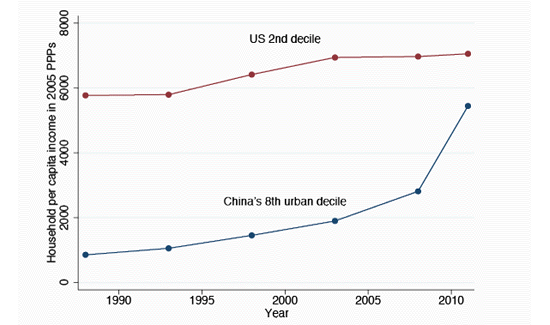
David Autor and colleagues have been trying to untangle the specific evidence - how much is 'trade' related, now much 'computerisation'. His team is showing that a $1,000 rise in import exposure per worker lowers the employment rate of non-college workers by an estimated 1.2%. Laurent Belsie has a summary of their work.
To approximate local labor markets, the authors examine 722 commuting zones (CZs), covering the entire mainland United States, from 1990 to 2007. They determine how susceptible each of these CZs was to technological change, based on Census data on occupational patterns, and to Chinese competition, measured by the local market's industry mix in 1980. The impact of technology or what the authors call "task-replacing technical change" through computerization is spread throughout the United States. In contrast, those CZs affected by trade competition from China are geographically concentrated, leading to quite a bit of geographical disparity."Trade competition leads to sharp declines in local manufacturing employment, with corresponding growth in local unemployment and non-employment, particularly among workers without college education. In contrast, exposure to technological change has largely neutral effects on overall employment, yet leads to substantial polarization of occupational composition within sectors."How can computerization have had such small, insignificant effects on manufacturing employment with all the labor-saving improvements of computer-aided manufacturing? Extending their study back to the 1980s, the authors find that computerization did have substantial impacts on job task composition in the 1980s and 1990s but not since then. In contrast, the effect of computerization in non-manufacturing industries has accelerated in that period, almost quadrupling from the 1980s to the 2000s. "Concurrent with the rapid growth of U.S. imports from China, the effect of trade competition on the manufacturing sector has become stronger over time, while the effect of technological change on employment composition in the manufacturing sector has subsided," the authors conclude.
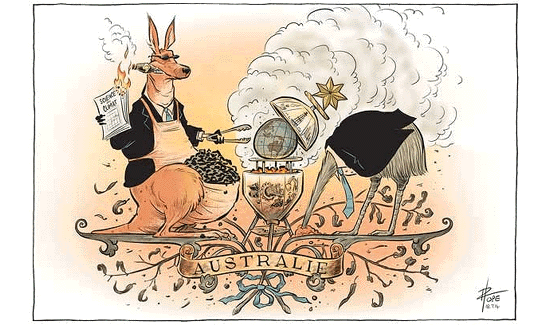
6. Green irony
Sulphur is the 9th most abundant element in the universe. We used to mine it, but it was a dangerous occupation because in its concentrated rock form it is dangerous stuff. Now is is produced as a by-product of the petrochemical industry. Even though we use it for all sorts of things, we produce much more than we can use and sulphur stockpiles are growing rapidly. The BBC explains:
And there it will sit until we need it again - because there is another source of demand for the element which looks set to grow steadily for the foreseeable future, agriculture.
Like the phosphate fertilisers that sulphuric acid helps to produce, the element sulphur is itself a nutrient for plants and animals (0.25% of your body is composed of sulphur, and it's not just in your hair). And the very same environmental restrictions that have created the sulphur glut also mean that farmers now need to buy it.
"Ironically, one of the reasons why we now need to add sulphur to the soil is because, as the legislation has got tighter on air emissions, there is actually less sulphur going into the soil through acid rain," explains Mike Lumley of Shell Sulphur Solutions, a unit of the Anglo-Dutch oil giant.
Today's sulphur glut will not last forever. Eventually either the sour oil and gas will run out, or the world will stop digging the stuff up as it switches over to cleaner (and potentially far cheaper) renewable energy sources.
Meanwhile, with the world's population set to reach 10 billion by mid-century, the need to boost crop yields will intensify - and that means a lot more demand for sulphur, both as a fertiliser itself, and to produce phosphate fertilisers.
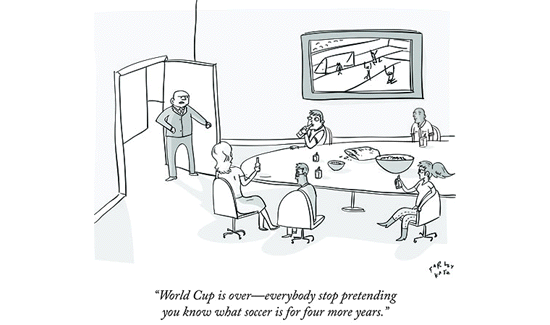
7. 'Growth makes up for a lot of imperfections'
"What we are creating here is a place where business can grow and people can afford to live," says a Houston booster. Its big, brash, impressive and booming. Lots of new jobs and a low cost of living is making Houston a middle-class magnet. One thing they aren't doing is focusing on density or trying to cram everyone inside a rural-urban boundary. But surprise, central Houston is booming too. (H/T Waymad.)
Marcus Davis, who grew up in the hardscrabble Fifth Ward, says that growth is simply part of the Houstonian ethos. “This place is pure opportunity, including for African-Americans,” he said at his successful and usually crowded restaurant, the Breakfast Klub, just outside downtown. Davis’s customer base includes young professionals and middle-class families. “This is a place where everyone wants to figure out how to do business. And since Houstonians like to do things over food, having a restaurant can be very lucrative.” The growth-friendly attitude is what holds everything together in Houston, and it will be crucial whenever the next slowdown comes - when oil prices could drop, say, to below $100 a barrel. It remains to be seen whether a large influx of newcomers to Greater Houston from the ocean coasts will clamor, as they have elsewhere - notably, in Colorado - for a more controlled, high-regulation urban environment.
For now, though, most Houstonians see the city as a place that works - for minorities and immigrants, for suburbanites and city dwellers - and few want to fix what isn’t broken. “The key to Houston’s future is to keep thinking about how to be a greater city,” notes David Wolff as he passes a new set of towers off the Grand Parkway. “This road, it wouldn’t be built in many places. People might talk about these things, but in most places, they don’t get done. In Houston, we don’t just talk about the future - we’re building it.”

8. Back to the future
Tech giant, Microsoft - which just this week announced 18,000 layoffs, many associated with its recent takeover of Nokia - is about to embark on a strategy that is completely unique, completely unusual for a tech company. It is not planning to be disruptive. It is planning to focus on its core operations, reinvent itself around what it has done best. It's so radical for a company in that sector, it is hard to know how seriously to take the new direction.
I don't think any tech giant has tried that before. As Clare Cain Miller noted:
“Our challenge and core priority is renewal of the mainstream work,” Mr. Nadella said Tuesday at the Fortune Brainstorm Tech conference. When his onstage interviewer, Walter Isaacson, responded that innovating by focusing on the existing core of the company is an unusual concept (though it really isn’t), Mr. Nadella responded, “Sometimes you have to.”In other words, he is trying to ensure that Microsoft doesn’t become the next, well, Microsoft.

9. Can sport kill countries?
Soccer news will echo for a while (no, it is soccer) and here's a bit more. Brazil spent US$14 billion getting its infrastructure ready or the 2014 tournament, and FIFA reportedly spent another US$4 billion. That made it the most expensive yet.
And, remember Greece and the Olympics?
But Russia is working hard to outdo the Brazilians. According to Spiegel, costs are exploding for the 2018 event. On a per seat basis, Brazil spent US$6,500. Russia is currently spending US$11,500.
When FIFA awarded the World Cup to Russia in 2010, a leading advisor to then President Dmitri Medvedev tweeted, "Dawaite bes otkatow," in Russian. Loosely translated, it means, "let's try to avoid corruption this time." There's much to suggest this was little more than a pious hope.
The World Cup stadium in St. Petersburg is expected to be the most expensive, with a cost of $16,500 for each of the around 70,000 spectator seats. The stadium has been under construction since 2007 and was originally scheduled for opening at the end of 2008, but it has been beset by delays. And costs have skyrocketed: It was supposed to cost $415 million, but current reports indicate the price tag has risen to as high as $1.2 billion. The opening is now planned for 2016. To be on the safe side, the city of St. Petersburg recently even considered constructing a back-up stadium with 25,000 seats just in case -- a site that could then be used by the second team of Russian Premier League club Zenit St. Petersburg after the tournament.
The problems with the stadium in St. Petersburg are not an isolated case. In December, a report in the daily Vedomosti startled the public with news that renovations of the venerable Moscow Olympic Stadium, originally estimated at $2.5 billion, could get even more expensive. The plans have since been slimmed down, with costs now only expected to be about $650 million.
Another problem is that many stadiums will be of little use after the tournament. The smallest World Cup arena is expected to hold 42,000 spectators, while the average attendance at Russian Premier League matches being a paltry 12,000. Besides, four cities hosting World Cup matches aren't even home to Premier League teams. "With the economic outlook for Russia darkening, the World Cup 2018 is likely to become deadweight to Russian economic development through the misallocation of scarce resources," Martin Müller, a professor at the University of Zurich wrote in his introduction to the June report.
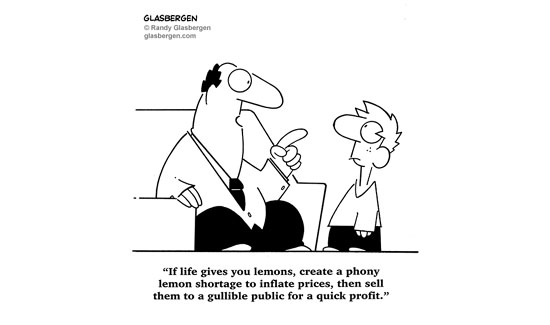
10. Today's quote
"You better cut the pizza in four pieces because I'm not hungry enough to eat six." - Yogi Berra
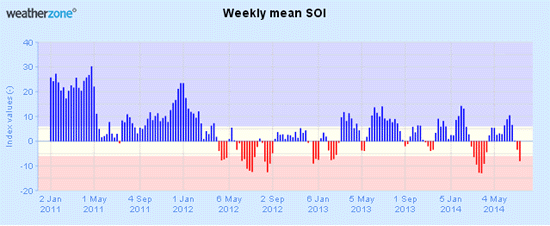
7 Comments
#1 and the future of food supply...
Researchers at the University of Minnesota's Institute on the Environment, focusing efforts to improve food systems on a few specific regions, crops and actions could make it possible to both meet the basic needs of 3 billion more people and decrease agriculture's environmental footprint.
http://m.phys.org/news/2014-07-cropland-billions.html
#1 more people, more food, less land.
http://m.blog.nature.org/science/files/2014/06/GlobalLandAg.jpg
"the widespread assumption among many environmentalists that agriculture is just chewing up more and more habitat at a faster rate each year is simply not correct."
How much of the reduction in land use is due to crowding out by bio-fuel production?
Interesting that they suggest New Zealand is one of the leading countries to reduce the amount of land given over to agriculture. Given the likes of forestry to dairy conversions going on, i'm quite surprised. Where in NZ are these large scale conversions away from agriculture?
"The decline of agricultural land in much of the world (e.g., New Zealand, Mongolia, and Poland) hides significant agricultural expansion elsewhere (like Vietnam, Indonesia, and Argentina), - See more at: http://blog.nature.org/science/2014/06/18/global-agriculture-land-susta…"
" Not all agricultural intensification can be made sustainable, and it is likely that much of the intensification to date represented in the global trend was not; the data show that the total area of “conservation agriculture” has oscillated wildly over the last 15 years (FAO 2014). Overall, agriculture has a long way to go to become truly sustainable. ♦ The levels of intensification which have happened to date are not sufficient to meet the projected demand for food by 2050, and in some places crop yields have stopped increasing (Ray et al. 2013). ♦ The global trend masks local and regional trends. So while agricultural area is down for the United States and Poland, it’s up for Argentina, Indonesia and Vietnam (see the map below for more). And deforestation and other land clearing is a continuing serious problem. ♦ Climate change will bring new challenges for agriculture, as more extreme weather conditions are expected to negatively impact yields (Lobell et al. 2008). Fortunately, many sustainable agriculture practices should also result in higher resilience meaning we can help protect against yield losses at the same time as we improve environmental performance (Lal 2006). - See more at: http://blog.nature.org/science/2014/06/18/global-agriculture-land-susta…"
dtc - perhaps the land taken out of ag due to tenure review is greater than that converted from forestry to ag. A drive through Otago etc will show just how much land is now reverting to matagouri and briar rose as a result of tenure review. Also the ever increasing creep of lifestyle blocks. Around Rotorua, over a period of 20years, a significant amount of land was planted in forestry on what was once farmland.
QEII Trust was set up in 1977. Since then 125,000 hectares of land has being covenanted. That is land that is taken out of ag permanently. Landowners throughout the country are voluntarily protecting around 125,000 hectares of their land with QEII covenants (figure at 30 June 2013). http://www.openspace.org.nz/Site/About_QEII/default.aspx
Interesting, i spent 6 weeks bicycling around the South Island last year, including the Mackenzie basin, over the Omarama Saddle, through central Otago and down the Clutha to the Catlins. But its 10 years since i lived down that way, without before and after photos it's impossible to tell what is reverting to bush and what was always like that.
I think a million odd ha of pastural leases recently went into the conservation estate in the SI.
#4. Growth does not bring wealth. It's ownership does that.
New Zealand illustrates that wonderfully. We work harder each year, and have less disposible and fewer choices each year.
We would be better to slow down, be picky about what trade we do - ensure we own our businesses and land - and make citizenship important - and work from having capital, not debt.
Leading to a richer,smaller, more relaxed population.

We welcome your comments below. If you are not already registered, please register to comment
Remember we welcome robust, respectful and insightful debate. We don't welcome abusive or defamatory comments and will de-register those repeatedly making such comments. Our current comment policy is here.